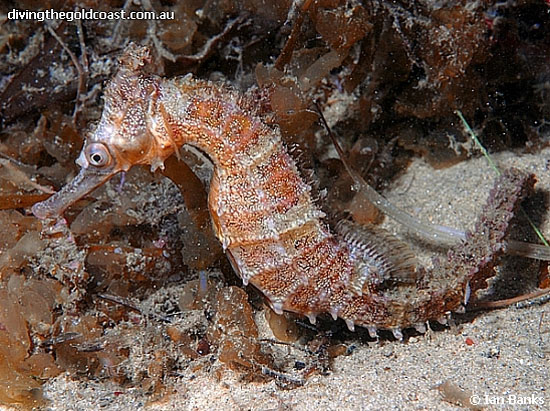| Syngnathidae (Pipefishes and seahorses), subfamily: Syngnathinae |
| 13 cm OT (male/unsexed); 11 cm OT (female); max. reported age: 5 years |
|
demersal; brackish; marine; depth range 0 - 46 m, non-migratory |
| Southwest Pacific: Australia. |
|
Dorsal soft rays (total): 17-18. This species is distinguished from its congeners by the following set of characters: trunk rings 11; tail rings 34-35; dorsal fin rays 17-18; pectoral fin rays 16; subdorsal rings 3; subdorsal spines 4, superior trunk ridge ending with 3 enlarged spines, the superior tail ridge commencing with one enlarged spine (3/0,1,0); cleithral ring spines 3, one small spine at each end of pectoral-fin base, none at gill-opening, large single or double spine at ventral extent of head; with 2 small lateral head spines, one directly posterior of eye, one anterodorsally of operculum and ventral of coronet; with a distinct snout spine; no parietal spine or diminutive if present; single eye spine, large and protruding dorsally; small single or double spine, rugose, posteroventrally of eye; the coronet, distinct and tall, protruding anteriorly in juveniles, angled
dorsoposteriorly in adults, and with 5 small spines present on apex in a star-like arrangement;
superior trunk with enlarged spines on first and eigth tail ridges (Ref. 125503). |
| Occur in coastal estuaries and embayments (Ref. 125503); in shallow, weedy inshore areas and Zostera seagrass beds; also on sponges. Also under jetties on holdfasts of kelp, and on other man-made structures such as shark nets. Diurnal and site faithful (Ref. 30915). Female max length (Ref. 42735). Ovoviviparous (Ref. 205). The male carries the eggs in a brood pouch which is found under the tail (Ref. 205). Minimum depth reported taken from Ref. 128812. |
|
Endangered (EN); Date assessed: 05 October 2016 (A2bc) Ref. (130435)
|
| harmless |
|
Fricke (1999, Ref. 33390) synonymized H. borboniensis with H. whitei, thus citing H. whitei as occurring in Reunion. Also in Ref. 53568. We follow Lourie et al (1999, Ref. 30915) in considering H. borboniensis a valid species. |
Source and more info: www.fishbase.org. For personal, classroom, and other internal use only. Not for publication.

